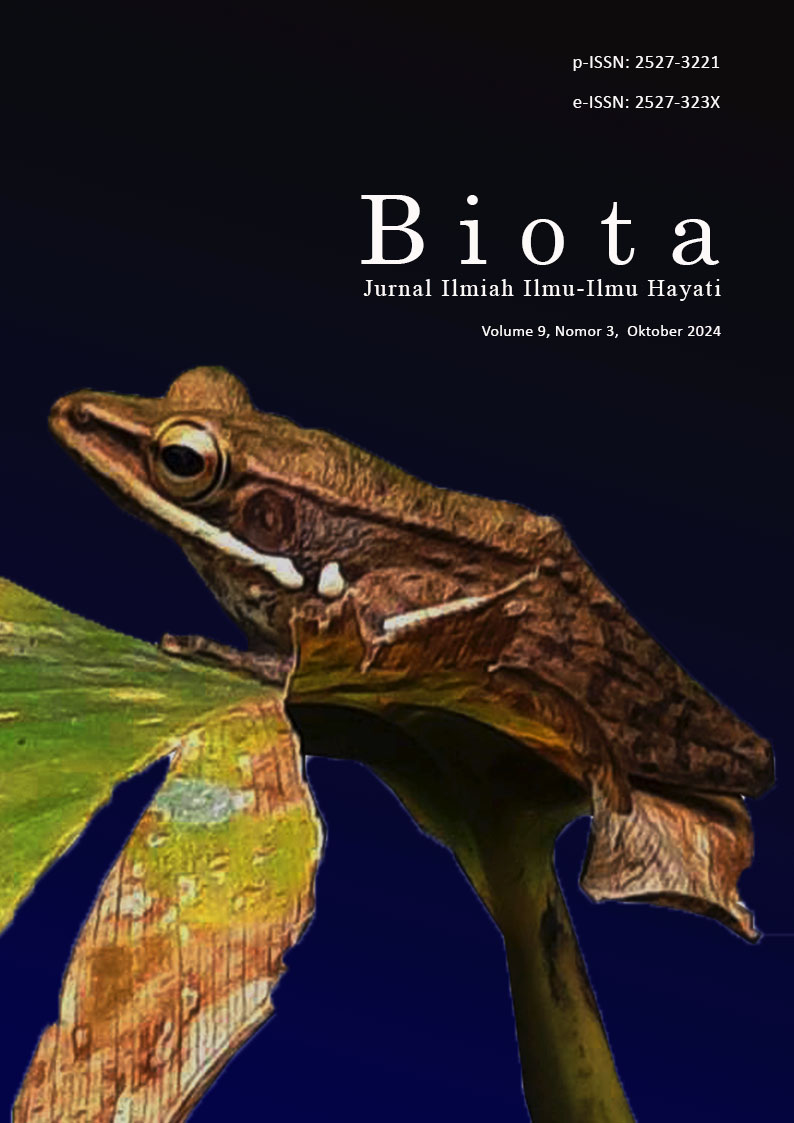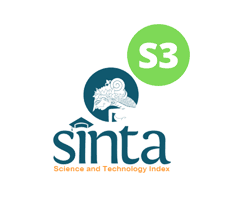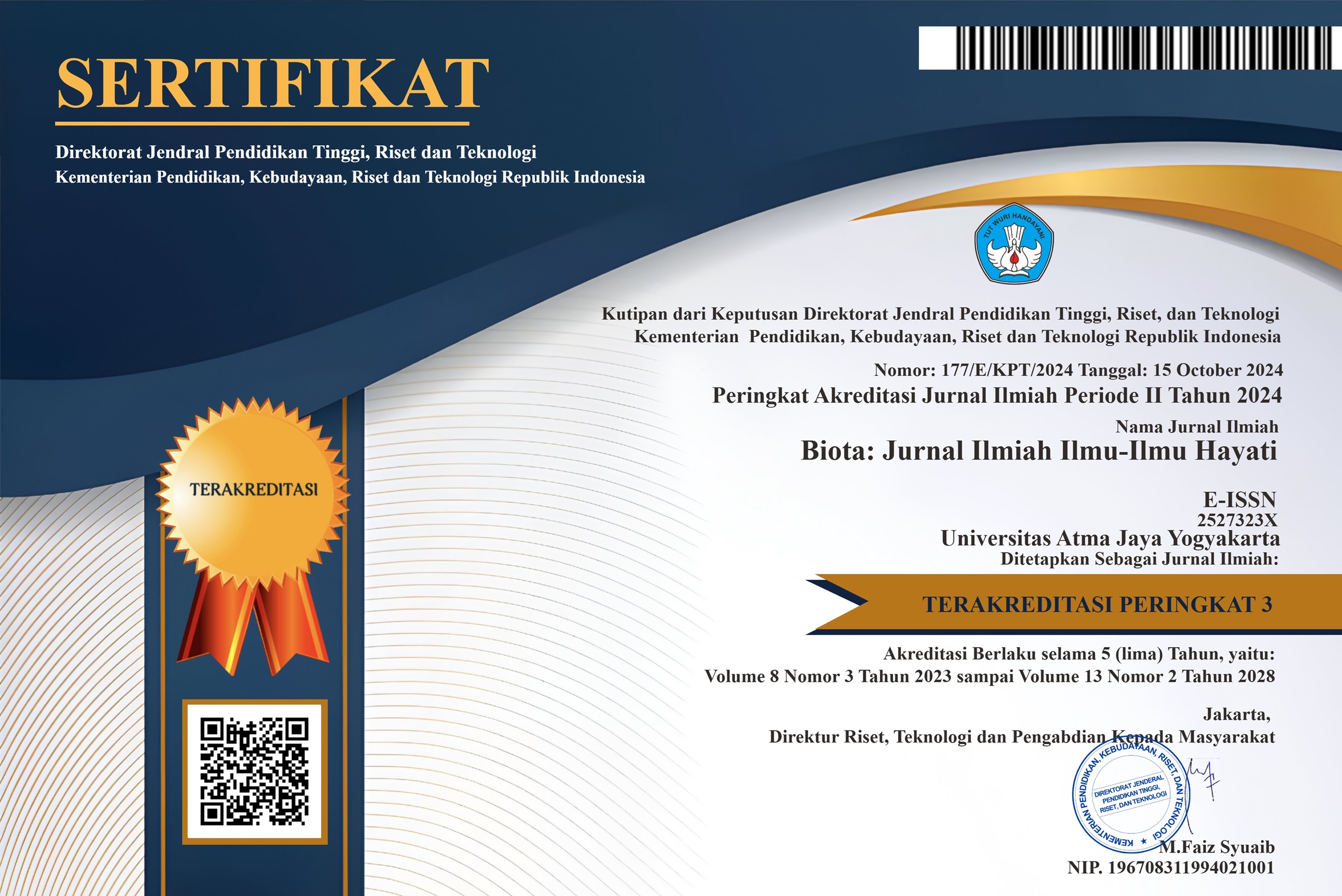Respon Morfo-anatomi dan Uji Histokimia Kemiri Sunan Terinokulasi Cendawan Endofit pada Tailing Tambang Emas
DOI:
https://doi.org/10.24002/biota.v9i3.6700Keywords:
Biodisel, cendawan DSE, Pb, tailing tambang emas, Reutealis trispermaAbstract
Kemiri Sunan (Reutealis trisperma (Blanco) Airy Shaw) merupakan tanaman penghasil minyak non pangan yang dapat digunakan sebagai agen fitoremediasi. Penelitian bertujuan untuk mengetahui respon pertumbuhan, anatomi, dan akumulasi Pb Kemiri Sunan yang diinokulasi jamur Dark Septate Endophyte (DSE) terhadap tailing tambang emas. Bibit berumur dua bulan yang telah diinokulasi jamur DSE 0,5% dipindahkan ke dalam pot berisi tailing tambang emas dengan konsentrasi berbeda dan ditanam selama 7 minggu. Parameter yang diamati meliputi tinggi tanaman, berat kering pucuk dan akar, luas permukaan daun dan anatomi jaringan. Analisis histokimia dilakukan untuk mengamati Pb dalam jaringan. Hasil penelitian menunjukkan bahwa konsentrasi tailing berpengaruh nyata terhadap tinggi tanaman dan parameter anatomi, tetapi tidak mempengaruhi berat kering tajuk dan akar maupun luas permukaan daun. Inokulasi DSE tidak berpengaruh nyata terhadap tinggi tanaman, berat kering pucuk dan akar, luas daun, dan parameter anatomi. Pada akar, akumulasi timbal diamati pada sel epidermis, korteks, berkas pembuluh, dan empulur akar, sedangkan pada daun diamati pada sel epidermis atas dan bawah, daerah antara xilem, dan jaringan parenkim. Inokulasi jamur DSE meningkatkan pertumbuhan dan menurunkan toksisitas Pb pada Kemiri Sunan.
References
Alkhatib, R., Bsoul, E., Blom, D.A., Ghoshroy, K., Creamer, R. & Ghoshroy, S. (2013). Microscopic analysis of lead accumulation in tobacco (Nicotiana tabacum var. Turkish) roots and leaves. Journal of Microscopy and Ultrastructure 1: 57-62.
Andriya, N.N., Hamim, Sulistijorini, Triadiati. (2019). The phytoremediation potential of non-edible oil-producing plants for gold mine tailings. Biodiversitas 20(10): 2949-2957.
Ban, Y., Zhouying, X.U., Yang, Y., Zhang, H. & Tang, M. (2017). Effect of dark septate endophytic fungus Gaeumannomyces cylindrosporus on plant growth, photosynthesis and Pb tolerance of maize (Zea mays L.). Pedosphere. 27: 283-292.
El-Banna, M.F., Mosa, A., Gao, B., Yin, X. & Wang, H. (2019). Scavenging effect of oxidized biochar against the phytotoxicity of lead ions on hydroponically grown chicory: an anatomical and ultrastructural investigation. Ecotoxicology and Environmental Safety 170: 363-374.
Fashola, M.O., Ngole-Jeme, V.M. & Babalola, O.O. (2016). Review heavy metal pollution from gold mines: environmental effects and bacterial strategies for resistance. International Journal of Environmental Research and Public Health 13: 1-20.
Franceschi, V.R. & Nakata, P.A. (2005). Calcium oxalate in plants: Formation and function. Annual Review of Plant Biology. 56: 41-71.
Gond, S.K., Bergen, M.S., Torres, M.S. & White Jr J.F. (2015). Endophytic Bacillus spp. produce antifungal lipopeptides and induce host defence gene expression in maize. Microbiology Research 172: 79-87.
Hamim, H., Hilmi, M., Pranowo, D., Saprudin, D. & Setyaningsih, L. (2017). Morpho-physiological changes of biodiesel producer plants Reutealis trisperma (Blanco) in response to gold-mining waste water. Pakistan Journal of Biological Sciences. 20(9): 423-435.
Hamim, Hanifatunisa, Hadisunarso, Setyaningsih, L., Saprudin, D. (2019). Lead (Pb) toxicity effect on physio-anatomy of bead-tree, jatropha, castor bean and Philippine-tung grown in water culture. BIODIVERSITAS 20(12): 3690-3697.
Hilmi, M., Hamim, H., Sulistyaningsih, Y.C. & Taufikurahman. 2018. Growth, histochemical and physiological responses of non-edible oil producing plant (Reutealis trisperma) to gold mine tailings. Biodiversitas 19 (4):1294-1302.
Irma, W. (2016). Pengaruh pemberian timbal (Pb) terhadap morfologi daun bayam (Amarantus tricolor L.) dalam skala laboratorium. Jurnal IPTEK Terapan 9(2): 179-184.
Johansen, D.A. (1940). Plant Microtechnique. McGraw-Hill. New York.
Khan, A.R., Waqas, M., Ullah, I., Khan, A.L., Khan, M.A., Lee, I.J. & Shin, J.H. (2017). Culturable endophytic fungal diversity in the cadmium hyperaccumulator Solanum nigrum L. and their role in enhancing phytoremediation. Environ Exp Bot. 135:126–135.
Kopittke, M., Asher, P.J. & Mensies, N. (2007). Toxic effect of Pb2+ on growth of cowpea (Vinga unguiculata). Environmental Pollution 150:280-287.
Li, X., Ma, L., Li, Y., wang, L. & Zhang L. (2019). Endophyte infection enhances accumulation of organic acids and minerals in rice under Pb2+ stress condition. Ecotoxicology and Environmental Safety 174: 255-262.
Líška, D., Martinka, M., Kohanová, J. & Lux, A. (2016). Asymmetrical development of root endodermis and exodermis in reaction to abiotic stresses. Annals of Botany 118: 667-674.
Pranowo, D., Herman, M. & Syafaruddin. (2015). Potensi pengembangan kemiri sunan (Reutealis trisperma (Blanco) Airy Shaw) di lahan terdegradasi. PERSPEKTIF 14(2): 87-101.
Sarwar, N., Imran, M., Shaheen, M.R., Ishaque, W., Kamran, M.A., Matloob, A., Rehim, A. & Hussain, S. (2017). Review phytoremediation strategies for soils contaminated with heavy metals: Modifications and future perspectives. Chemosphere 171: 710-721.
Schneider, C.A., Rasband, W.S. & Eliceiri, K.W. (2012). NIH Image to ImageJ: 25 years of image analysis. Nature Methods 9: 671 – 675.
Seregin, I.V., Kozhevnikova, A.D. (2011). Histochemical methods for detection of heavy metals and strontium in the tissues of higher plants. Russian Journal of Plant Physiology 58(4): 721-727.
Setyaningsih, L., Wulandari, A.S., Hamim, H. (2018). Growth of typha grass (Typha angustifolia) on gold-mine tailings with application of arbuscular mycorrhiza fungi. BIODIVERSITAS 19(2): 454-459.
Tang, L., Ying, R.R., Jiang, D., Zeng, X.W., Morel, J.L., Tang, Y.T. & Qiu, R.L. (2013). Impaired leaf CO2 diffusion mediates Cd-induced inhibition of photosynthesis in the Zn/Cd hyperaccumulator Picris divaricata. Plant Physiology and Biochemistry 73: 70-76.
Tauqeer, H.M., Ali, S., Rizwan, M., Ali, Q., Saeed, R., Iftikhar, U., Ahmad, R., Farid, M, & Abbasi, G.H. (2016). Phytoremediation of heavy metals by Alternanthera bettzickiana: growth and physiological response. Ecotoxicology and Environ Safety 126: 138-146.
Tupan, C.I. & Azrianingsih, R. (2016). Accumulation and deposition of lead heavy metal in the tissues of roots, rhizomes and leaves of seagrass Thalassia hemprichii (Monocotyledoneae, Hydrocharitaceae). Bioflux - Aquaculture, Aquarium, Conservation & Legislation 9(3): 580-589.
Downloads
Published
How to Cite
Issue
Section
License
Copyright (c) 2024 Elena Theana, Hamim, Yohana Caecilia Sulistyaningsih, Surono

This work is licensed under a Creative Commons Attribution-NonCommercial 4.0 International License.
Authors who publish with Biota : Jurnal Ilmiah Ilmu-Ilmu Hayati agree to the following terms:
- Authors retain copyright and grant the Biota : Jurnal Ilmiah Ilmu-Ilmu Hayati right of first publication. Licensed under a Creative Commons Attribution-NonCommercial 4.0 International License that allows others to share the work with an acknowledgment of the work's authorship and initial publication in this journal.
- Authors are able to enter into separate, additional contractual arrangements for the non-exclusive distribution of the journal's published version of the work (e.g., post it to an institutional repository or publish it in a book), with an acknowledgment of its initial publication in Biota : Jurnal Ilmiah Ilmu-Ilmu Hayati, and as long as Author is not used for commercial purposes.













